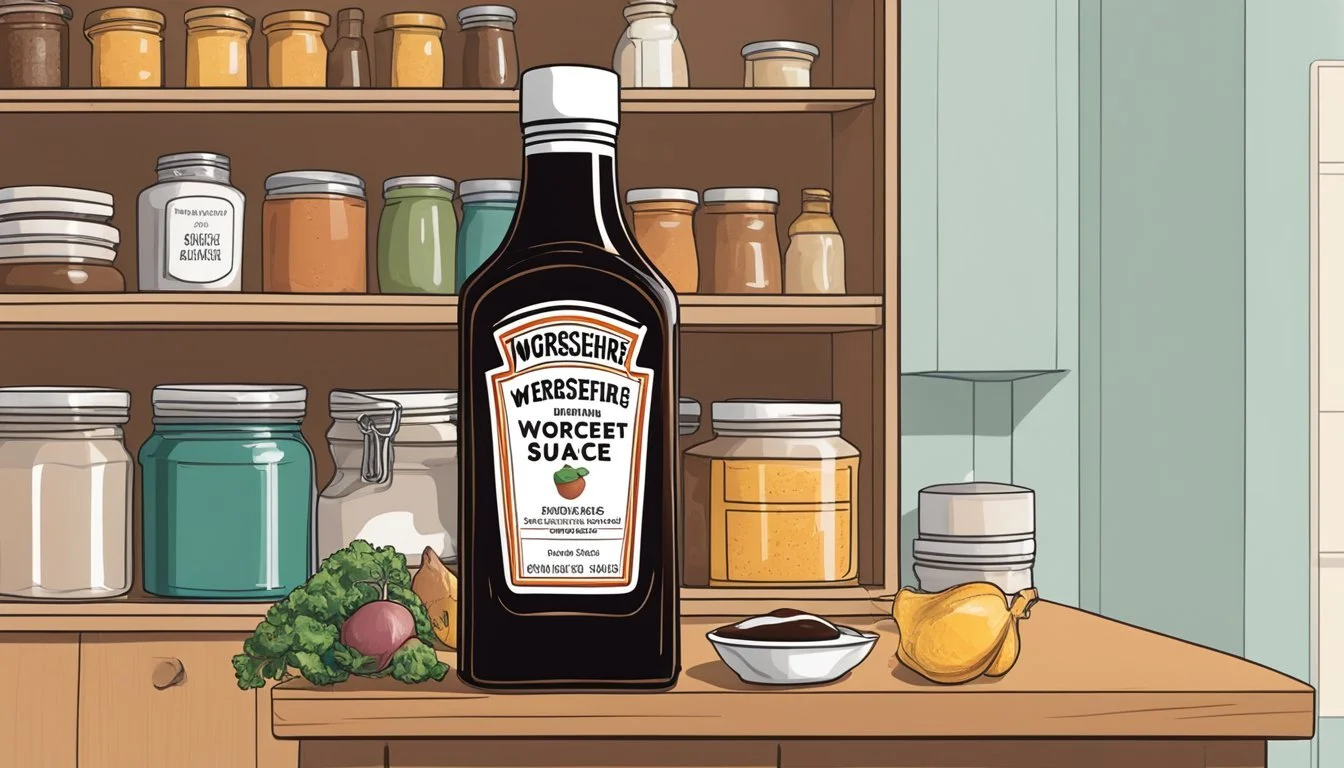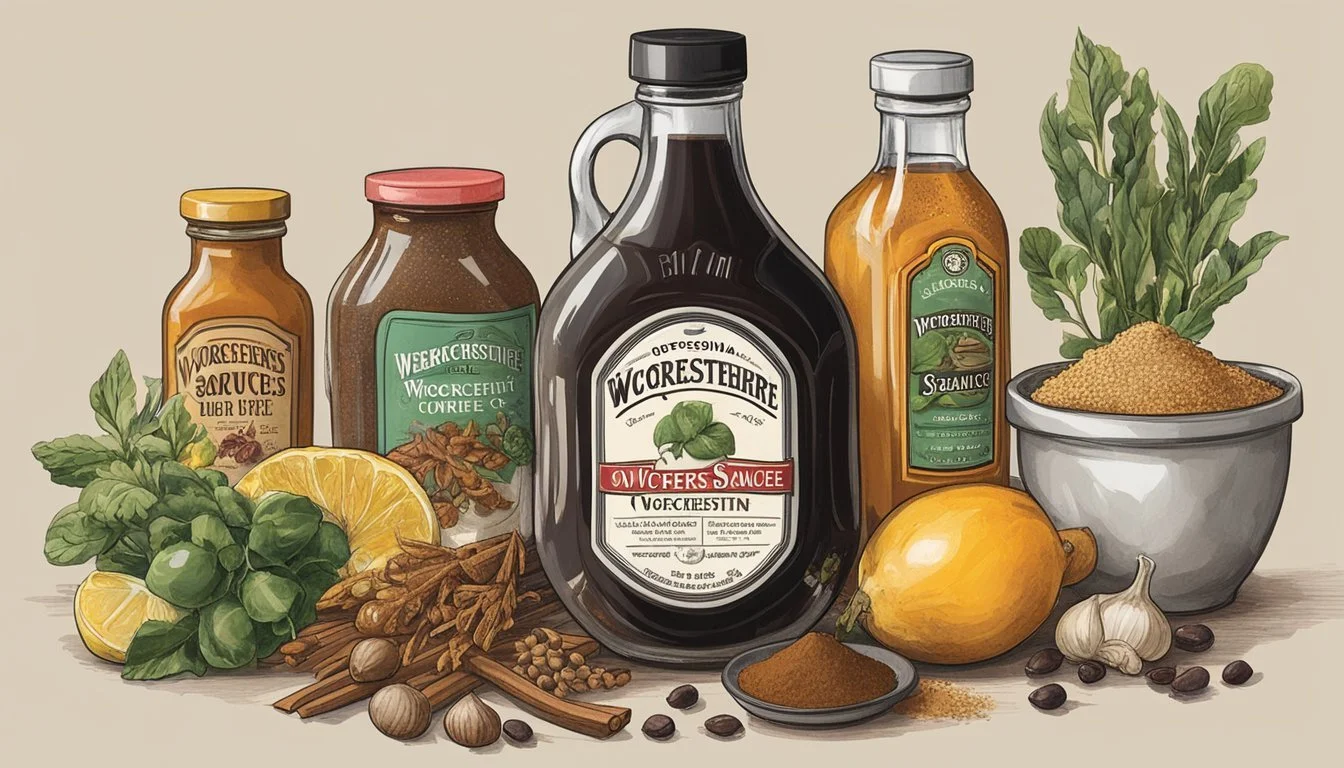Does Worcestershire Sauce Go Bad?
Understanding Shelf Life and Storage
Worcestershire sauce, a condiment with a complex flavor profile, has a notable longevity in terms of shelf life. Its unique composition includes ingredients like vinegar, molasses, and soy sauce, which are well-known for their preservative properties. Consequently, an unopened bottle of Worcestershire sauce can typically last for up to 3 years without refrigeration. Once opened, the quality is best maintained for about a year when stored in a pantry and can extend up to 3 years if kept in the refrigerator.
Quality degradation in Worcestershire sauce is gradual, and while it may not spoil in the traditional sense, over time, there can be a noticeable change in its flavor. Signs of spoilage, though rare, might include an off smell, a change in appearance, or a sour taste. To ensure the sauce retains its intended taste and quality, proper storage is essential, with a cool, dark pantry or kitchen cupboard being ideal before opening and the fridge being the best place post-opening.
Understanding Worcestershire Sauce
Worcestershire sauce is a complex condiment recognized for its bold flavor profile and versatility in culinary applications. Its distinct taste is achieved through a precise combination of ingredients and a unique fermentation process.
Composition and Ingredients
Primary Ingredients:
Vinegar: Serves as the base and provides acidity.
Molasses: Adds sweetness and contributes to the dark color.
Tamarind: Imparts a fruity sourness.
Anchovies: (What wine goes well with anchovies?) Deliver umami and a subtle fish flavor.
Garlic and Onions: Enhance the sauce with aromatic elements.
Sugar and Salt: Balance the flavors.
Secondary Ingredients: May include additional spices and seasonings to refine the flavor profile. All these ingredients also act as natural preservatives, extending the shelf life of the sauce.
Fermentation Process
The fermentation process is essential for developing Worcestershire sauce's unique characteristics. After combining the ingredients, the mixture undergoes a period of aging, which can range from several months to years. During this time, the natural fermentation allows flavors to meld and intensify, creating a rich and complex taste.
Culinary Uses of Worcestershire Sauce
Worcestershire sauce is a versatile condiment that enhances meat dishes, marinades, dressings, soups, and beverages like Bloody Mary. Its robust flavor can also be used as a secret ingredient to add depth to a wide range of recipes, elevating the overall taste experience.
Shelf Life and Spoilage
Worcestershire sauce is a condiment with a long shelf life, but recognition of spoilage signs is vital to ensure quality. Understanding the differences in storage duration between unopened and opened bottles can help consumers make informed decisions about their usage.
Unopened vs Opened Bottles
Unopened bottles of Worcestershire sauce can typically last from 1.5 to 3 years. They retain their quality for several months past the best-by date, depending on storage conditions. In contrast, opened bottles should be consumed within about 1 year if stored in the pantry and up to 3 years when kept refrigerated. However, as long as it does not show signs of spoilage, the sauce is generally safe to consume beyond these timeframes.
Identifying Spoilage Signs
To ensure the Worcestershire sauce is fit for consumption, look for these spoilage signs:
Unpleasant smell: An off odor suggests spoilage.
Mold growth: Visible mold on the sauce or the inside of the cap is a clear indicator.
Change in color: Any significant alterations in color imply degradation.
Buildup of gas: If the bottle appears swollen or gas is released upon opening, it may have gone bad.
What Happens When It Goes Bad
If Worcestershire sauce has gone bad, it should not be consumed. Spoiled sauce might not necessarily cause illness, but its quality in terms of flavor and aroma will be diminished, making it unsuitable for enhancing dishes. While a bottle beyond its best-by date might still be safe to use, any signs of spoilage warrant disposal of the product.
Storing Worcestershire Sauce
The longevity of Worcestershire sauce, whether opened or unopened, is significantly influenced by its storage conditions. Understanding the optimal environment can help maintain its quality and flavor for as long as possible.
Optimal Storage Conditions
To retain the quality of Worcestershire sauce, it should be kept in a cool and dry place, away from direct sunlight and heat sources. The ideal temperature for storage is below 80°F (27°C). An unopened bottle benefits from these conditions, remaining stable for a considerable period.
Refrigeration Benefits
Once Worcestershire sauce is opened, the best way to preserve its freshness is by refrigerating it. The cool temperature of the refrigerator slows down any deterioration process, maintaining the sauce's quality. It is essential to ensure that the bottle is sealed tightly to prevent the introduction of contaminants and odors from other foods.
Pantry vs Fridge Storage
For unopened bottles, pantry storage is typically sufficient. However, refrigeration can extend the quality life of an opened Worcestershire sauce:
Pantry: An unopened bottle can be stored here, keeping it sealed and in a stable environment.
Fridge: Opened bottles should be stored in the refrigerator, which benefits both safety and flavor preservation, extending its usable life for up to one year.
Consumption and Safety
Understanding the changes in quality and identifying safety concerns are essential when deciding to consume Worcestershire sauce past its best-by date.
Quality Over Time
Worcestershire sauce typically maintains good quality for 18 months to 3 years when unopened. The natural preservatives such as vinegar and molasses slow down degradation, allowing the sauce to retain its taste and flavor for a lengthy period. After opening, the sauce’s quality, especially its texture and flavor, may gradually diminish, but it can still remain consumable for up to a year in the pantry and around three years in the refrigerator.
Safety Concerns of Spoiled Sauce
The safety of Worcestershire sauce hinges on its storage conditions. Its preservatives work to inhibit bacterial and fungal growth, reducing safety concerns. However, if the sauce develops an off odor, changes in texture, or signs of mold, these are clear safety warnings. Consuming spoiled sauce poses health risks and should be avoided.
When to Discard the Sauce
A bottle of Worcestershire sauce should be discarded in the following situations:
The best-by date has passed by several years, especially if changes in appearance are noted.
There are signs of spoilage such as mold, unsettling odor, or changes in flavor.
The bottle has been opened and stored improperly for an extended period.
Condition Action Passed best-by date Assess quality Unpleasant odor Discard the sauce Mold or spoilage visible Discard immediately
Consumers should trust their senses and prioritize safety when deciding whether to discard or consume Worcestershire sauce.
Frequently Asked Questions
When it comes to Worcestershire sauce, consumers often have questions about its storage, shelf life, and usability post expiration. This section answers the most common inquiries to ensure the quality and safety of this condiment.
Does Worcestershire Sauce Need to Be Refrigerated?
After opening, Worcestershire sauce does not require refrigeration, but it may extend its shelf life. Pantry storage at room temperature is acceptable, especially if the bottle will be used within a few months. However, if a bottle will be kept for an extended period, refrigerating it is beneficial.
How Long Can You Keep an Opened Bottle?
An opened bottle of Worcestershire sauce can last 1-3 years before it begins to deteriorate in quality. This time frame is a guideline; the actual shelf life can vary based on the brand and storage conditions. The sauce should be kept sealed when not in use to limit exposure to air, which can accelerate degradation.
Can You Use It After the Expiration Date?
Worcestershire sauce can typically be used after the expiration date printed on the bottle. Unopened, it can last several years past its best-by date due to the presence of vinegar and salt, which are natural preservatives. However, one should trust their senses; a change in smell could indicate spoilage. If the smell is sour or rancid, the sauce should be discarded.
Enhancing Dishes with Worcestershire Sauce
Worcestershire sauce is renowned for its ability to add a rich umami flavor to a diverse array of dishes. Its complex taste and versatility make it a staple in both home kitchens and professional culinary environments.
Recipes Featuring Worcestershire Sauce
A quintessential component in a classic Bloody Mary, Worcestershire sauce is also a key ingredient in many recipes. It elevates the taste of marinades for meats, bringing a deep savory note that can transform a simple steak into a gourmet experience. Additionally, the sauce is often used to enhance gravies and stews, providing chefs with a multipurpose tool to add depth to their creations.
Meatloaf: Incorporate 2 tablespoons of Worcestershire sauce for a tangy twist.
Caesar Salad Dressing: A dash imparts complexity to the dressing.
Creative Uses in Cooking
In cooking, Worcestershire sauce serves not just as a condiment but as a catalyst for creativity. Chefs and home cooks alike experiment with it to add unexpected flavors to dishes. It can be brushed onto vegetables before roasting for an extra dimension or whisked into marinades to tenderize and flavor proteins.
Vegetable Glaze: Brush Worcestershire sauce on grilled vegetables.
Burgers: Mix a tablespoon into the patty mixture for a savory punch.
Substitutions for Dietary Restrictions
For those with dietary restrictions, such as a vegan or vegetarian lifestyle, traditional Worcestershire sauce, which contains anchovies, may not be suitable. However, there are now several brands offering vegan versions of the sauce, which exclude anchovies while still capturing the essence of the classic flavor profile.
Vegetarian Shepherd's Pie: Use a vegan Worcestershire sauce alternative to keep the dish plant-based.
Marinated Tofu: A vegan Worcestershire alternative can be used to infuse tofu with umami.
Additional Considerations
When assessing the longevity of Worcestershire sauce, several additional factors play a pivotal role. These not only impact the sauce’s shelf life but also affect when it’s time to discard it.
Impact of Environmental Factors
Temperature and light are critical environmental factors that influence the degradation of Worcestershire sauce. An opened bottle should ideally be kept in a cool, dry place or refrigerated to extend its lifespan. Exposure to heat or direct sunlight accelerates deterioration by promoting the growth of bacteria and mold, and this can cause the sauce to spoil prematurely.
Optimal storage conditions:
Refrigerate once opened: Below 40°F (4°C)
Keep unopened in a cool, dry place away from direct sunlight
Differences Among Brands
The shelf life can vary between brands due to differences in preservative content and formulation. Brands like Lea & Perrins may last longer due to higher concentrations of sodium, which acts as a natural preservative. While some brands may only recommend keeping an opened bottle for up to a year, others may claim up to three years when refrigerated.
Shelf life variation (Post-opening):
Pantry: Approximately 1 year
Fridge: Up to 3 years (Certain brands)
Signs of Deterioration
Indicators that Worcestershire sauce has begun to deteriorate include noticeable changes in texture, sediment formation, and off-odors. If the sauce develops a murky appearance or a slimy texture, it should be discarded. While not as potent in flavor, sauces like soy sauce and oyster sauce can serve as guidelines; when similar changes are observed in these related condiments, it is generally time to throw them away.
Indicators of spoilage:
Texture: Sliminess, unusual thickness
Sediment: Excessive or aberrant sedimentation
Odor: Development of an unpleasant or unusual smell






